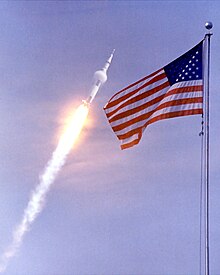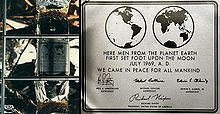NASA
Appearance

The National Aeronautics and Space Administration (NASA) is the agency responsible for the civilian space program of the United States, and for its long-term aerospace research. It was established by the National Aeronautics and Space Act of 29 July 1958. It has run the United States’s space exploration programs, including the world’s first Moon landings, ever since. It is one of three government space agencies, including the ones of the Soviet Union/Russia and China, to have sent humans into space. It is currently overseeing the International Space Station and the Artemis program. It is currently led by Administrator Bill Nelson, who reports to President Joe Biden.
Quotes
[edit]
FIRST SET FOOT UPON THE MOON
JULY 1969, A.D.
WE CAME IN PEACE FOR ALL MANKIND.
- For the benefit of all.
- NASA motto
- The Congress hereby declares that it is the policy of the United States that activities in space should be devoted to peaceful purposes for the benefit of all mankind.
- National Aeronautics and Space Act of 1958, which created NASA, signed by US President Dwight D. Eisenhower (29 July 1958)
- To improve life here. To extend life to there. To find life beyond.
- The NASA Vision
- To understand and protect our home planet, To explore the universe and search for life, To inspire the next generation of explorers.
- NASA Mission
- Shaping the Future: Launching New Endeavors to Inspire the Next Generation of Explorers.
- Motto of NASA's Office of Education
- NASA, the National Aeronautics and Space Administration. Where else but in Texas would men set up to administer space?
- James Cameron, in Cameron Country, broadcast on BBC TV, July 12, 1969.
- We lack any sort of device that can... detect life. We don't have a life meter. ...We don't have a general pupose life meter that can detect life as we don't know it. Obviously, if it's life as we know it, there are all sorts of features. ...NASA plans a mission to... Enceladus... which has a plume of organic material spewing out, and they want to fly through that plume... The question is, what are they going to put onboard that would return a result "Yes, we have found life"... How would you do that? What exactly do you measure?
- Paul Davies, "The Demon in the Machine by Paul Davies" (Sep 7, 2019) 6th International FQXi Conference, "Mind Matters: Intelligence and Agency in the Physical World" 3:22.
- It [Traveling to Mars] is important for our future. If the dinosaurs had a space program, they'd still be here.
- There's been a lot of discussion about NASA culture and changing that. I think our culture has always been one of trying to do a very difficult job and do it well.
- Mark E. Kelly in an interview prior to STS-121
- HERE MEN FROM THE PLANET EARTH
FIRST SET FOOT UPON THE MOON
JULY 1969, A.D.
WE CAME IN PEACE FOR ALL MANKIND.- Lunar landing commemorative plaque of Apollo 11, originally suggested and designed by NASA's head of technical services Jack Kinzler.
- Well, today physicists peering into the infinitely small realms of subatomic particles find reaffirmations of religious faith. Astronomers build a space telescope that can see to the edge of the universe and possibly back to the moment of creation. So, yes, this nation remains fully committed to America's space program. We're going forward with our shuttle flights. We're going forward to build our space station. And we are going forward with research on a new Orient Express that could, by the end of the next decade, take off from Dulles Airport, accelerate up to 25 times the speed of sound, attaining low Earth orbit or flying to Tokyo within 2 hours. And the same technology transforming our lives can solve the greatest problem of the 20th century. A security shield can one day render nuclear weapons obsolete and free mankind from the prison of nuclear terror. America met one historic challenge and went to the Moon. Now America must meet another: to make our strategic defense real for all the citizens of planet Earth.
- Ronald Reagan, 1986 State of the Union Address

- Introductory page of the official Artemis program site at NASA
- With Artemis missions, NASA will land the first woman and first person of color on the Moon, using innovative technologies to explore more of the lunar surface than ever before. We will collaborate with commercial and international partners and establish the first long-term presence on the Moon. Then, we will use what we learn on and around the Moon to take the next giant leap: sending the first astronauts to Mars.
- We’re going back to the Moon for scientific discovery, economic benefits, and inspiration for a new generation of explorers: the Artemis Generation. While maintaining American leadership in exploration, we will build a global alliance and explore deep space for the benefit of all.
- We will build an Artemis Base Camp on the surface and the Gateway in lunar orbit. These elements will allow our robots and astronauts to explore more and conduct more science than ever before.
- All that we build, all that we study, all that we do, prepares us to go.
- OUR SUCCESS WILL CHANGE THE WORLD



